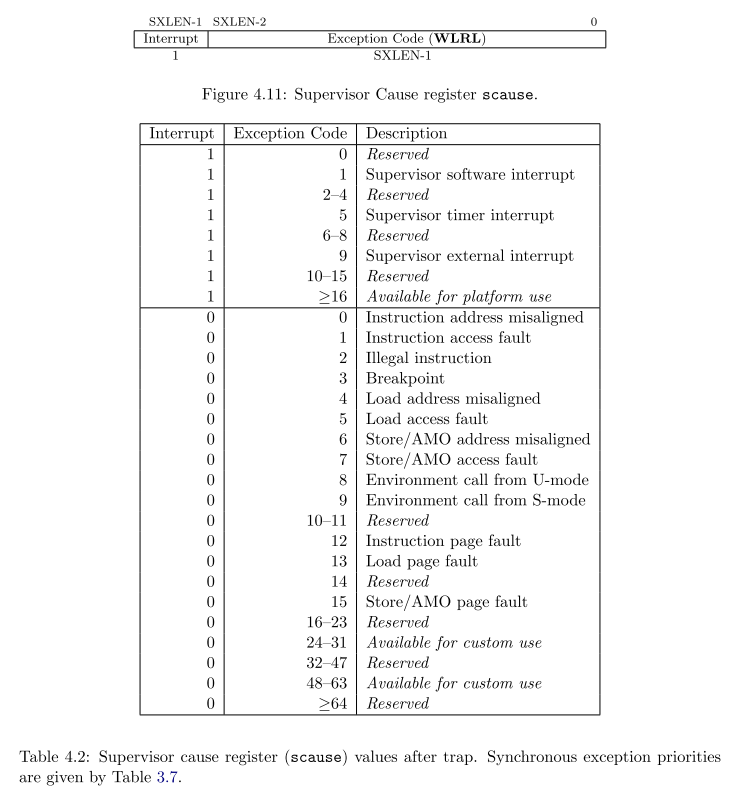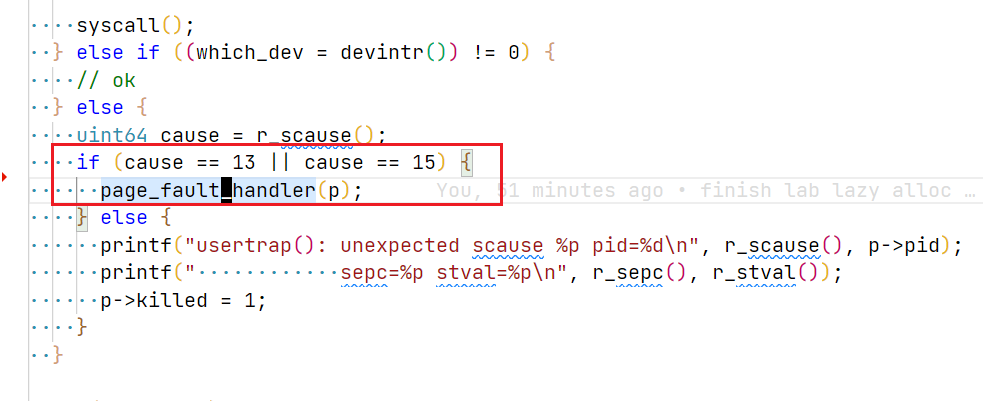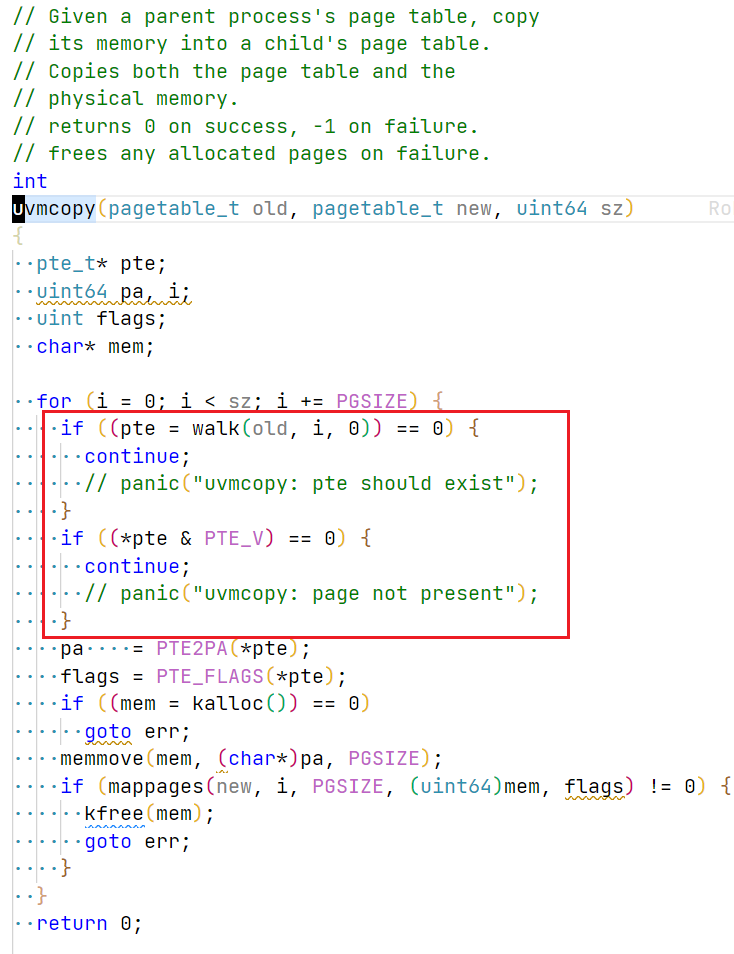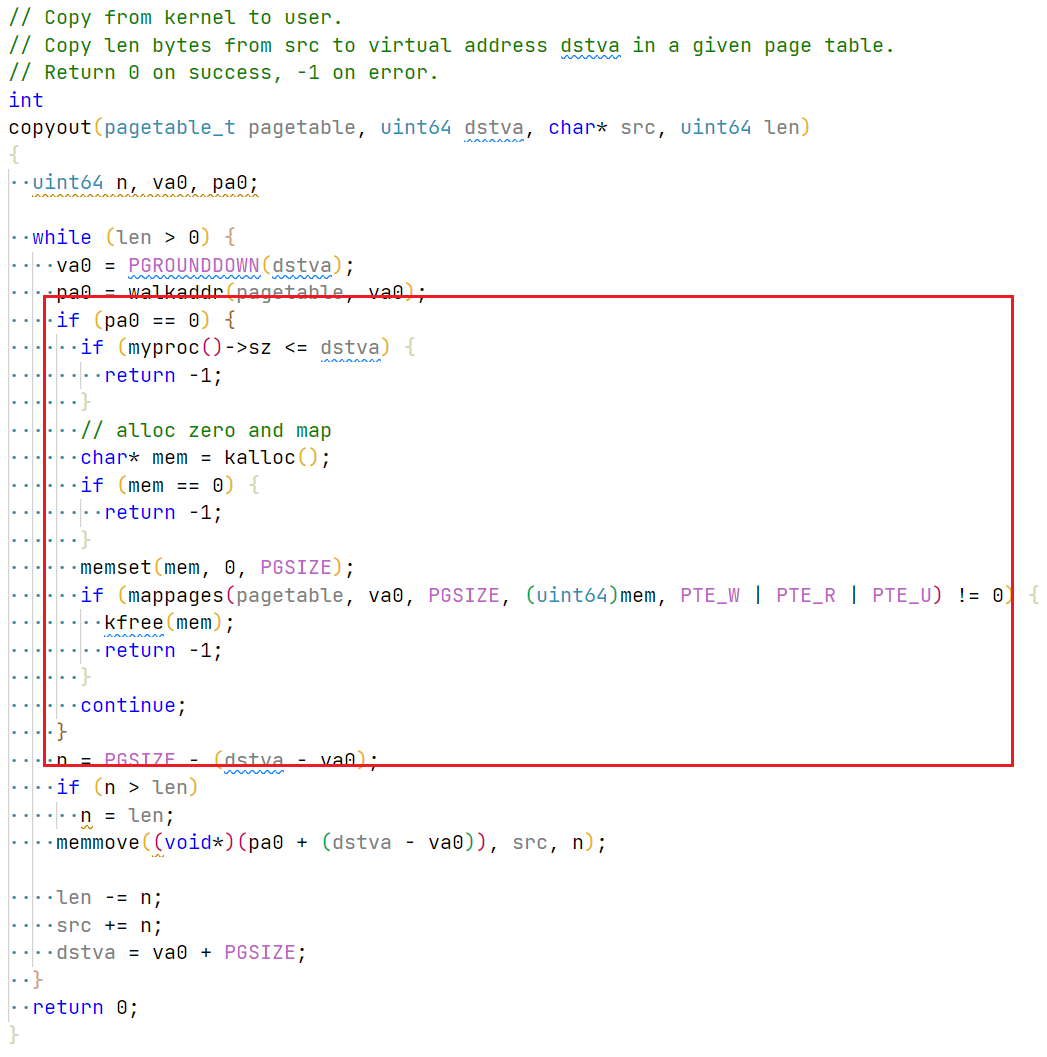0. 前言·
本实验为MIT 6.s081的第五个实验,主题和内存的lazy allocation相关,是page table的应用之一。其余应用包括不限于(copy on write, zero fill on demand, demand paging)。
本实验分为三个task:
- 取消sbrk系统调用中的内存分配。即准备从eagerly分配变为lazy分配。
- 实现lazy allocation,然后通过echo hi测试。
- 继续完善lazy allocation,完成所有测试。包括lazytests和usertests。
1. 原理·
本次实验非常简单,简单说下目标:xv6使用提供sbrk函数用于扩展或收缩用户进程的可用物理内存,proc结构体中的sz字段代表当前所申请过的内存大小。 lazy allocation基于这样一个观察:
用户进程通过会申请比实际需要更多的内存,申请后,很多内存并不多被使用。
使用lazy allocation后, sbrk只是标记进程申请过多少内存,但是并不实际申请物理内存给进程。当进程在后续读写内存时,由于页表中并不存在该页映射(因为没有实际申请),会触发page fault, 内存发现page fault后,再分配该内存。大大加快了sbrk调用,降低了实际物理内存占用。
目前几乎所有主流操作系统,都会采用该策略。比如linux的malloc。
为完成本实现,要明确的是,内核如何识别page fault?
我们曾提到trap一共有三种:
- syscall
- exeception
- interrupt
page fault属于exception。所以在xv6中,可在 usertrap 函数中做识别处理。那如何区分page fault和其它exception呢?在ricsv中, scause寄存器保存了出现trap的原因,具体见下表:

可以看到13和15都和page fault相关。
另外:
stval寄存器保存了引发page fault时的虚拟地址。sepc寄存器保存了引发page fault时的指令地址。
2. 实现·
1. Eliminate allocation from sbrk()·
原文要求:
Your first task is to delete page allocation from the sbrk(n) system call implementation, which is the function sys_sbrk() in sysproc.c. The sbrk(n) system call grows the process’s memory size by n bytes, and then returns the start of the newly allocated region (i.e., the old size). Your new sbrk(n) should just increment the process’s size (myproc()->sz) by n and return the old size. It should not allocate memory – so you should delete the call to growproc() (but you still need to increase the process’s size!).
修改 sys_sbrk系统调用:
1 | uint64 |
如上,取消原来的growproc,即不再进行内存分配和映射。
2. Lazy allocation·
原文要求:
Modify the code in trap.c to respond to a page fault from user space by mapping a newly-allocated page of physical memory at the faulting address, and then returning back to user space to let the process continue executing. You should add your code just before the
printfcall that produced the “usertrap(): …” message. Modify whatever other xv6 kernel code you need to in order to getecho hito work.
首先要增加page fault处理,该处理在 usertrap 函数中:

page_fault_handler的实现如下:
1 | // page fault handler to lazy alloc mem |
另外,还需要修改 uvmunmap函数:

以uvmunmap将在进程销毁时调用,当进程销毁时,其有效va(由proc->sz表示)范围内可能存在一些未分配的页。即 pte 的 PTE_V并不有效。这是正常逻辑,不再需要panic。
完成这部分代码添加后,执行 echo hi 应该能正常通过。
3. Lazytests and Usertests·
原文要求:
We’ve supplied you with
lazytests, an xv6 user program that tests some specific situations that may stress your lazy memory allocator. Modify your kernel code so that all of bothlazytestsandusertestspass.
- Handle negative sbrk() arguments.
- Kill a process if it page-faults on a virtual memory address higher than any allocated with sbrk().
- Handle the parent-to-child memory copy in fork() correctly.
- Handle the case in which a process passes a valid address from sbrk() to a system call such as read or write, but the memory for that address has not yet been allocated.
- Handle out-of-memory correctly: if kalloc() fails in the page fault handler, kill the current process.
- Handle faults on the invalid page below the user stack.
原文已经给出了所有的提示,一条条处理即可:
首先处理 sbrk() 带负数参数的场景:
1 |
|
我个人的处理时,对于负数场景,立即释放内存,去除映射。
第二条和倒数第二条和最后一条已经在 Lazy allocation 小节中处理。
第三条 Handle the parent-to-child memory copy in fork() correctly
修改 uvmcopy函数:

第四条 Handle the case in which a process passes a valid address from sbrk() to a system call such as read or write, but the memory for that address has not yet been allocated.
这一条相对难改,需要追踪下 write和 read系统调用的流程,以write为例:
write -> uservec -> usertrap -> syscall -> sys_write -> file_write -> writei -> either_copyin -> copyin
来到 copyin 函数,添加代码:

这是因为 srcva 所代表的用户进程虚拟地址所在页,可能并不分配和映射, walkaddr无法找到对应页, 返回的 pa0将为0,对于这种情况,需要做一次 lazy allocation.
同理,修改 copyout 函数:

最后运行 lazytests 和 usertests ,检验是否全部通过。
3. 总结·
本实验是page table的应用之一,学习了 lazy allocation的设计与实现。回忆起之前在头条上看到别人提问 为什么反复调用malloc函数,物理内存开销没有增长?现在能够理解,若只malloc,而没有对申请后的页进行写入,是不会分配实际的物理页的。

